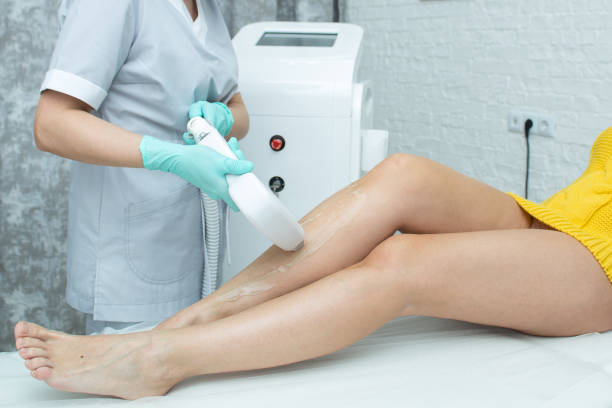
Sensitive skin reacts more easily to external factors like certain ingredients in skincare products, environmental conditions, and even physical touch. Common symptoms include redness, itching, burning sensations, and dryness. When it comes to leg hair removal, these reactions can be exacerbated if the wrong method or products are used.
Choosing the Right Leg Hair Removal Tips
There are several methods for leg hair removal, each with its pros and cons. For sensitive skin, it’s crucial to choose a method that minimizes irritation and discomfort. Here are some of the most popular options:
1. Shaving
Pros:
- Quick and convenient
- Inexpensive
- Can be done at home
Cons:
- Can cause razor burn and ingrown hairs
- Needs frequent repetition
Tips for Sensitive Skin
- Use a sharp, clean razor to avoid tugging and irritation. Dull blades can cause nicks and exacerbate skin sensitivity.
- Shave in the direction of hair growth to minimize the risk of ingrown hairs. Shaving against the grain can lead to hair being cut too short and curling back into the skin.
- Apply a thick layer of shaving cream or gel formulated for sensitive skin. These products are designed to reduce friction and provide a protective barrier between the razor and your skin.
- After shaving, moisturize with a fragrance-free, soothing lotion to keep the skin hydrated. Look for ingredients like aloe vera, chamomile, and vitamin E, which are known for their calming properties.
2. Waxing
Pros:
- Longer-lasting results compared to shaving
- Hair grows back finer over time
Cons:
- Can be painful, especially for sensitive skin
- Risk of redness and irritation
Tips for Sensitive Skin
- Opt for hard wax, which is gentler on the skin than soft wax. Hard wax adheres to the hair rather than the skin, reducing the likelihood of irritation.
- Ensure the wax is at the right temperature to avoid burns. Test a small amount on your wrist before applying it to your legs.
- Apply a pre-wax oil to create a barrier between the wax and the skin. This helps to minimize skin irritation and allows the wax to grip the hair more effectively.
- Post-wax, use a cooling gel or aloe vera to soothe the skin and reduce redness. Avoid hot showers or baths for at least 24 hours to prevent further irritation.
3. Sugaring
Pros:
- Natural ingredients (usually sugar, lemon, and water)
- Less painful than waxing
- Gentle on the skin
Cons:
- Can be messy and time-consuming to prepare at home
Tips for Sensitive Skin
- Ensure the sugar paste is at a lukewarm temperature to avoid burns. Cold sugar paste won’t spread properly, and hot paste can burn sensitive skin.
- Apply a thin layer of the paste in the opposite direction of hair growth and remove it in the direction of growth. This technique helps reduce the risk of ingrown hairs and minimizes skin irritation.
- After sugaring, apply a soothing lotion or aloe vera to calm the skin. Sugaring is less likely to irritate, but it’s still important to care for your skin post-treatment.
4. Depilatory Creams
Pros:
- Easy to use
- Painless
Cons:
- Can contain harsh chemicals
- Risk of allergic reactions or irritation
Tips for Sensitive Skin
- Choose a depilatory cream specifically formulated for sensitive skin. These products typically contain milder ingredients and soothing agents.
- Do a patch test 24 hours before full application to check for any adverse reactions. Apply a small amount to a discreet area of your skin and wait to see if any irritation occurs.
- Follow the instructions carefully and avoid leaving the cream on for longer than recommended. Overexposure can lead to chemical burns and severe irritation.
- Rinse thoroughly with cool water and apply a fragrance-free moisturizer. Avoid scrubbing the skin while rinsing to prevent further irritation.
5. Epilators
Pros:
- Long-lasting results
- Hair grows back finer
Cons:
- Can be painful
- May cause redness and irritation
Tips for Sensitive Skin
- Use an epilator designed for sensitive skin, with adjustable speed settings. Slower speeds can be gentler on the skin and reduce pain.
- Exfoliate the skin before epilating to reduce the risk of ingrown hairs. Use a gentle scrub or exfoliating glove to remove dead skin cells.
- Stretch the skin taut to minimize pain and discomfort. This helps the epilator to grasp the hair more effectively and reduces the risk of pinching the skin.
- Post-epilation, apply a soothing lotion or gel to calm the skin. Look for products with anti-inflammatory properties to reduce redness and swelling.
Pre-Removal Preparation
Proper preparation can make a significant difference in reducing irritation and achieving smoother results. Here are some pre-removal tips for sensitive skin:
- Exfoliate Gently: A day before removing leg hair, gently exfoliate your skin to remove dead skin cells and prevent ingrown hairs. Use a mild exfoliant or a soft brush designed for sensitive skin. Avoid harsh scrubs that can damage delicate skin.
- Hydrate: Well-hydrated skin is less likely to get irritated. Drink plenty of water and use a hydrating lotion regularly. Dehydrated skin can be more prone to cuts and irritation during hair removal.
- Patch Test: Always perform a patch test when trying a new hair removal product to ensure it doesn’t cause an adverse reaction. This step is crucial for avoiding widespread irritation or allergic reactions.
Post-Removal Care
Taking care of your skin after hair removal is just as important as the removal process itself. Here are some post-removal care tips:
- Cool Down: Use a cool compress or a cold shower to soothe the skin and reduce any redness or inflammation. Avoid hot water as it can exacerbate irritation.
- Moisturize: Apply a fragrance-free, gentle moisturizer to keep the skin hydrated and prevent dryness. Opt for products with calming ingredients like aloe vera, chamomile, and cucumber extract.
- Avoid Tight Clothing: Wear loose-fitting clothes for a day or two after hair removal to avoid friction and irritation. Tight clothing can rub against sensitive skin and cause discomfort.
- Stay Out of the Sun: Avoid direct sun exposure for at least 24 hours after hair removal to prevent further irritation. If you need to be outside, apply a broad-spectrum sunscreen with a high SPF to protect your skin.
Final Words
Leg hair removal doesn’t have to be a painful or irritating process, even for those with sensitive skin. By choosing the right method, preparing your skin properly, and taking care of it post-removal, you can achieve smooth, hair-free legs without discomfort. Remember to always listen to your skin and adjust your routine as needed. If you experience persistent irritation or other issues, consider consulting a dermatologist for personalized advice.
By following these tips, you can enjoy the benefits of leg hair removal without compromising the health and comfort of your sensitive skin. Experiment with different methods to find what works best for you and ensure that your hair removal routine is as gentle and effective as possible.

